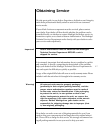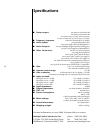
41
the Left and Right speakers while leaving the Center, Subwoofer and
Surround speakers unaffected.
One could attempt to restore the proper balance by marking a “cali-
brated” point on the preamplifier’s volume control and then using only
the surround decoder to adjust the volume of the system, but this
method is both crude and imprecise, yielding inconsistent performance
at best.
the SSP must not
be in a tape loop
The last remaining alternative would seem to be to insert the decoder
“within” a preamplifier by hooking it up in a tape loop. Unfortunately,
this setup returns the Left and Right outputs of the decoder to the
preamplifier, where they can be inappropriately changed without
changing the Center and Surround outputs. It is therefore inappropri-
ate to place surround sound decoders in a tape loop.
It would seem that there is no way to properly integrate a surround
sound processor with a preamplifier for a high quality, dual-purpose
system.
the SSP & the Nº383 The Nº383 solves this dilemma by virtue of a specially-designed sur-
round sound processor interface. When you select the SSP name for a
particular input on the Nº383, the output level and balance controls
are defeated and the preamplifier operates in a “unity gain” mode, pass-
ing whatever signal enters that input through the preamplifier section
of the Nº383 without changing its volume in any way. In fact, the dis-
play indicates that a line-level signal is being “passed through” un-
changed by showing “LINE” in the display where the volume would
normally be displayed. The power amplifier section then behaves as al-
ways, providing the power required to drive the loudspeakers.
Thanks to this design innovation, it is possible for the first time to cor-
rectly integrate a surround sound processor with an integrated ampli-
fier, sending the processor’s Left and Right outputs through the Nº383.
Since the output level of these channels cannot be changed by the
Nº383 while in SSP mode, the preamplifier section cannot corrupt the
careful calibration of the processor’s output levels. And since multi-
channel sources are fed directly to the processor’s audio input(s) at a
line level, input calibration cannot be disturbed by the preamplifier.
noise in a/v systems In some cases, connecting your audio and video systems together can
result in noise, typically a 50/60 Hz or 100/120 Hz hum. The most
common cause for this noise is a “ground loop” caused by the presence
of two ground references in the system: one from the power company
and another from the cable-television company, or the satellite dish.


















